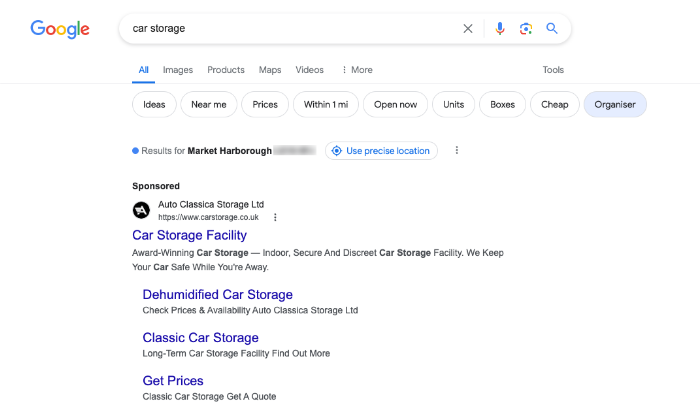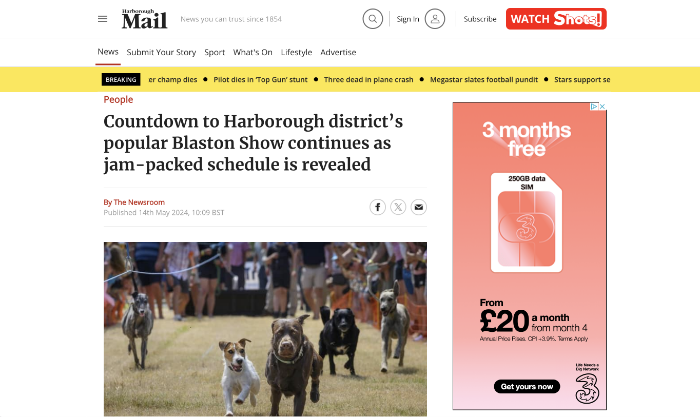
Businesses ready to scale and grow can benefit from including Google Ads in their marketing strategy. This can include display and search ads which both can reach your target audience in a different way and approach.
Our blog post will look at the main differences between the two types of ads and the benefits of each. As part of this, it will help to identify if your business will likely reach your campaign goals with display or search advertising, or potentially both are needed as they also work well in unison together.
Firstly we will take a look at what search and display ads are and when it is likely for your potential customers to see them online if you were to run campaigns in the future for your business.
Search Advertising Campaigns
When referring to search advertising this is typically referred to as ‘pull’ advertising. Whereas when we talk about display advertising this is a form of ‘push’ advertising, which we explain in more detail below in our post.
A search ad is specifically shown on search engines, so with Google Ads it would be displayed within the search engine results pages on Google.
With search ads, the most visible positions are above the organic search results, which will have a headline, display URL and description text. With the ability to have ad extensions too, such as product features.
Search campaigns are a ‘pull’ form of advertising because they are shown when someone is searching for your product or services based on your selected keywords used within the Google Ads account when setting up the campaign.
High Return On Ad Spend
A search campaign on Google Ads when delivered effectively with the right keywords, quality score, landing page directing visitors to and bid amount. They can deliver a high conversion rate giving an impressive return on your ad spend.
This is due to when ads are shown on search engines the visitor is looking for more information or a solution to a problem which your product or services offer. They are further along the sales funnel and have a high intent to buy.
Also marketing budget is only used when a visitor clicks through on Google Ads for search advertising, as it is a pay-per-click advertising model.
With the ability to identify exactly how every £1 was spent to identify what worked well and what areas could be improved for your marketing campaign.

Targeting & Lead Generation
Due to the precise targeting parameters available within Google Ads for your search advertising, it is an impactful way of generating high quality leads for your business with a high purchase intent.
With that in mind, if your business services are needed in a quick and short term capacity which likely to be searched on Google, your search ads can give them an immediate solution ahead of your competitors.
For example, if someone’s fuse box has blown they would be in urgent need of an electrician. They would typically do a Google search for relevant keywords and locations such as ‘Emergency electrician in Leicester’.
They are likely to not need re-targeting ads and want to quickly find a relevant supplier to call immediately, typically found on mobile devices (which can also be specifically targeted).
Search advertising is also effective if you want to target a local area, as you have the ability to target by location. Therefore it is ideal for businesses with a physical shop or if services are limited to a particular radius and not wishing to waste money advertising to an area you do not offer. Helping your business to reach the right audience.
Display Advertising Campaigns
As mentioned above display ads are referred to as ‘push’ advertising. They are paid placements across the Google Display Network (GDN) which includes over 2 million sites. Therefore, display advertising can be seen across websites, blogs and apps to name just a few.
The ads are shown depending on your targeting parameters, such as being interest based for your target audience so you can reach them on sites they spend most of their time online viewing. A Display ad allows businesses and advertisers to build awareness with potential customers.
When ads earn space this is usually seen in various visual formats such as banner ads, video ads or expandable ads often seen above or to the right of content. Such as a blog post or article the audience is interested in.
Search and display ads do have similarity with how ads are targeted, such as using specific keywords and specific audience segments to ensure advertising campaigns are shown to the right users on the internet.
However, display ads are paid for by the number of impressions, Cost-Per-Thousand (CPM) whereas search ads are a pay-per-click model in comparison. This is partly because the primary goal of using display ads is to visually grab attention to a product or service, whereas search ads are more geared towards clicking through to the website.

Visual Content & Increased Awareness
The benefit of display ads is their visual nature, which is ideal for the right advertisers, such as holidays or clothing which benefit from being seen rather than read about. Ad formats include the use of images or video ads, with video proven to deliver a high engagement level across sites.
Typically, display ads are used to help businesses drive increased awareness and visibility during the earlier stages of the customer journey in the sales funnel. This makes it a prime time to create ads for those purchases which naturally have a longer sales funnel due to the value such as a new car, technology or luxury buyers.
Therefore, they may need more interaction with a business before committing to making a purchase, which is ideal for display ads so seeing advertising on websites of interest and continue advertising to people who have interacted previously with the business with re-marketing.
Display ads work effectively in particular if you are offering a product or service that is unlikely to be searched for on Google, such as a product which is new to market which needs increased awareness first.
Equally niche or luxury buyers can be targeted via display ads, by being displayed on websites know of interest and with target keywords as opposed to targeting on search engines via. search ad.
Display Ads versus Search Ads
When it comes to deciding to run a new campaign for either display or search ads, as can see from above there are different advantages to each.
However, if marketing budget allows it, then often it is recommended to use them in unison together. As you are able to reach a wider target audience as well as during different stages of the customer journey.
Both are effective marketing tools to reach potential customers to increase brand awareness, increase traffic and ultimately increase conversions for your business.
With there being differences between sectors and industries, it is recommended for the best results to ensure you fully understand your target demographic, their behaviours, interests and their likely touch points with your business. It is worthwhile potentially testing both display and search ads and seeing how each perform and can be optimised.
How Can We Help?
We hope you found our blog post useful to understand how both display ads and search ads can be of benefit to help your business grow and scale. Google Ads are an impactful tool when delivered correctly to drive increased traffic and conversions.
At 1PCS Creative we are a Google Partner and have the right knowledge and expertise to deliver Google Ads which deliver a high return on your ad spend. We take the time to get to know your business and target market, which will help us identify the right marketing plan for you.
Please feel free to get in touch to discuss how we can help.
Ben Webster
Creative director at 1PCS. Addicted to design, SEO, pizza and helping companies big and small succeed online.

